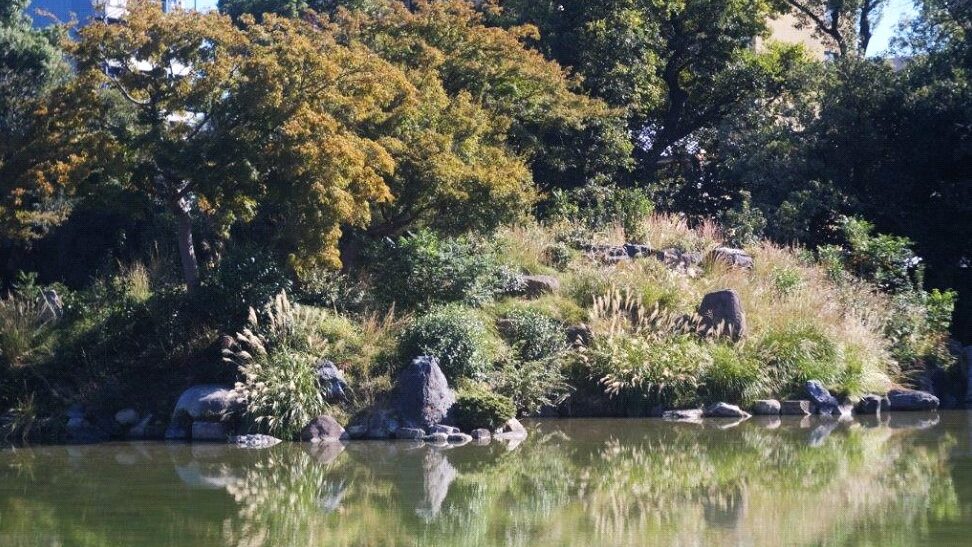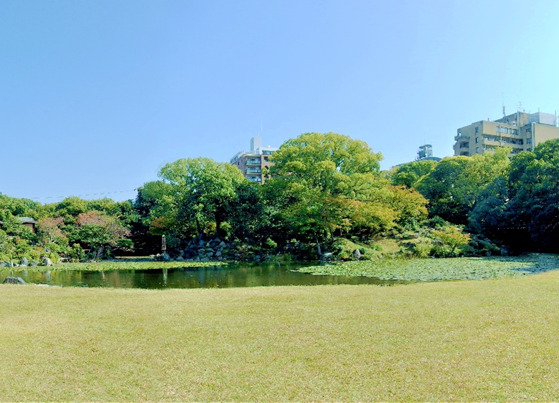
Close


渉成園の主景をなす、印月池エリアへようこそ!
もっと詳しく
次なる見処は、分岐点に位置しています。
印月池
右手に広がるのは、水面に東山から上る月を刻む池。庭園の中心に位置する大池は渉成園の主景です。大切なお客様をもてなすにふさわしい広々とした景色となっています。
かつて、舟着き待合「漱枕居」から「臥龍堂の鐘の音」を合図に、客人は舟で縮遠亭への船旅を楽しんだのち、お茶のもてなしを堪能しました。

野趣あふれる景色作り
印月池に浮かぶ南側の島を「南大島」と呼んでいます。
南大島には一年中野花、下草が揺れています。
通常、それらは日本庭園では雑草として、すべて除去すべき対象ですが、あえて部分的に残しています。
要所には手を入れ、見所となる勇壮な石組みは際立たせ、その添景となる紅葉の美しいハゼやススキをふさわしい場所に残し、いつでも面白い景色が見られるよう創意工夫を行っています。
南大島のサウンドスケープ
草は虫の住処。夏の終わり、職人たちは園内の外周から草刈りをスタートさせます。次第に包囲網を縮めながら南大島へと虫達を追い込んでゆきます。
秋の芝生広場では南大島からの虫達の大合唱が響き渡ります。
南大島の景観
南大島の景観の特徴は起伏のある地形と美しい稜線ですが、周辺家屋の目隠しとして大きく育てられたクスノキがその稜線を隠し、また成長した根が石組の間に入り込み景石に影響を及ぼしていた為、慎重に協議が進められ、2016年伐採工事が実行されました。

伐採の結果、南大島の美しい稜線、荘厳な石組の景色が復活しました。周辺家屋の景観も含め、その姿が渉成園らしい特色ある魅力を持つ景色になるような提案を常に考え続けています。
響きあういのち、生物多様性の島
京都駅周辺市街地エリアは緑地の乏しいコンクリートジャングル。その中の陸の孤島である渉成園。
人間にも、いきもの達にとっても貴重なレフュージア(避難地)がこの庭園です。

庭園内でも特に参観者から池を隔て隔離された南大島に私達職人は着目し、通常、日本庭園からは排除されるような多様な生物群が生息できる環境を育んでいきたいと考えています。 東本願寺御用達として、真宗大谷派の教えを受け止め「あらゆる命が守られ、響き合う場所」として育成管理を進めております。
よろしければこちらから簡単なアンケート(所要時間:1分以下)にご協力ください。

Welcome to the main view point of Shoseien Garden, South Island/Ingetsu-chi Pond Area!
Ingetsu-chi Pond
A pond with the moon etched upon its surface. The large pond at the garden’s center is Shōsei-en’s principal scenery. It is a broad landscape fit for entertaining important guests with.
Using the sound of the bell at Garyū-dō Bell Tower as a signal, guests once enjoyed boat rides from Sōchin-kyo Teahouse to Shukuen-tei Teahouse before reveling in a tea reception.

Creating Scenery Brimming with Rusticity
On the South Island, wildflowers and undergrowth sway throughout the year. In Japanese gardens, ordinarily all of these ought to be removed as weeds, but here we have deliberately kept some of them.
By working on key areas, making sure that the dynamic stone arrangements stand out as highlights, and leaving Japanese wax trees, with their beautiful autumn colors, and Chinese silver grass in appropriate places, we are using ingenuity so that interesting scenery can be seen at all times.
The South Island Soundscape
Grass is a habitat for bugs. At the end of summer, our gardeners begin cutting the grass at the garden’s outer perimeter. By gradually closing in on them, we push these bugs toward the South Island. In autumn, the lawn area resonates with a chorus of bugs singing from the South Island.
The South Island Landscape
The South Island’s characteristic features are its undulating topography and beautiful ridges. But a camphor tree grown large as a screen for surrounding buildings was concealing those ridges and its roots were growing into the stone arrangement, which was impacting the scenic stones. As a result of careful discussions, the camphor tree was cut down in 2016.

As a result, the South Island’s beautiful ridges and majestic stone arrangement were restored. We are always thinking of suggestions to give the garden’s scenery, which includes the landscape of surrounding houses, an attractiveness that features Shōsei-en’s unique quality.
Life that Resonates Together and an Island of Biodiversity
The streets around Kyoto Station are a concrete jungle with little green space. In that context, Shōsei-en is a lonely little land island. This garden is a precious refugia both for people and for other living things.

Inside the garden too, our gardeners pay special attention to the South Island, which viewers are separated from by a pond. We hope to nurture an environment where a diverse range of living things that would usually be expelled from a Japanese garden can live. As Higashi Hongan-ji Temple’s exclusive gardening company, we continue our garden management under the teaching of the Shinshu Otani branch of Buddhism,“Protect all living things in a place where they resound together.”
Please click here and fill out the short survey (takes less than 1 min) if you're happy to help us.